Preparing Your Pup for Their First Time in the Water
Lucky Dog Bark & Brew helps pet owners prepare their pups for a safe and fun first swimming experience in this blog post. We cover:
When the weather is warm and the days are long, there’s nothing more refreshing than jumping into a nice, cool lake, pool, or ocean. Sharing this experience with your furry friend is a great way to bond and find more opportunities to make life-long memories together. However, it’s important to do so safely by preparing your pet for their first swimming experience the right way.
Can All Dogs Swim?
Before you start preparing your dog for their first swimming lesson, it’s important to realize that not all dogs can swim. Some dogs will take to the water like fish to the sea while others will sink quicker than the boat with a hole in the bottom. Whether or not your dog is a good swimming candidate largely depends on their body shape and size. For instance, broad-chested breeds with short, stubby legs will find it more difficult to stay afloat. This is why Bulldogs typically don’t make great swimmers.
Likewise, dogs with flat faces that already struggle to breathe (i.e. Pugs) can become easily fatigued by swimming. Very small breeds like Chihuahuas can also have trouble in natural bodies of water as they struggle against large waves and currents. Give your pup an honest assessment of their capabilities before deciding to take the first plunge.
#1 – Take It Slow
It’s common for dogs to be nervous when first being introduced to the water. Take it slow and understand that your furry friend might not be keen on jumping in right away. If they are scared, don’t force the issue by trying to drag them in.
Start by finding a quiet, shallow part of the water and asking your pup to follow you in. Give your pet lots of praise when they do follow you in, and encourage them to stay nearby in case they need assistance. Only after your dog starts to feel comfortable in the shallow water should you proceed to coax them into deeper waters with their favorite toy.
#2 – Get a Life Vest
When first learning how to swim, it’s a good idea to have your pal wear a life vest. Even breeds that aren’t naturally good swimmers but who still enjoy the water can have a safe swimming experience by wearing a life vest. This device helps your furry friend stay afloat, minimizing their likelihood of drowning in the water.
Life vests are especially helpful for dogs who are very afraid of the water. By taking the physical stress off their bodies, life vests are able to help prevent your fearful pup from becoming over-fatigued. Remember: Even experienced swimmers can be overtaken by unexpected waves or currents. Especially if you plan on swimming in the ocean, it’s a smart idea to make sure your dog is wearing a life vest.
#3 – Don’t Drink the Water
While out swimming with your friend, it’s important that you let them know they should not drink the water. Lakes, ponds, oceans, and even swimming pools all contain harmful materials that can have serious consequences for your pet’s health. If you’re planning to swim in a natural body of water, make sure you’re aware of any safety advisories or closures related to blue-green algae infestation or other bacteria.
After your swim, be sure to monitor your dog’s and watch for any signs of illness. Waterborne diseases like giardia can impact your pet quickly and severely, and can even be fatal if left untreated.
#4 – Talk to Your Vet
If you’re worried about waterborne diseases or how your pet will respond to their water, speak to your vet about preventative treatments. Pet owners that spend lots of time outdoors with their furry friends should discuss their options for preventative medications. For instance, since ticks are prevalent in North Carolina, it’s recommended that dogs in this region receive a Lyme vaccine as a precaution.
Another vaccine that is recommended for dogs spending lots of time outside is the Leptospira vaccine. Leptospirosis is a disease most commonly transmitted through water found in swamps, lakes, and ponds. When left untreated, it can lead to kidney failure and even death.
#5 – Wash After Swimming
After your swim, it’s important to wash your dog to help get rid of any lingering bacteria. If you can’t give them a full wash, a rinse should suffice until you’re able to fit in a dog bath. Not only will bathing help reduce the likelihood of your pet ingesting harmful materials while grooming themselves later, but it can also help alleviate itchy skin caused by sand, pool chemicals, and other debris.
If you’ve recently been swimming with your dog and need to schedule a bath, Lucky Dog Bark & Brew has you covered. Come by every Tuesday and Thursday for our weekly $15 Beer & Bath Night to get your dog a quick wash while you enjoy a cold brew!




